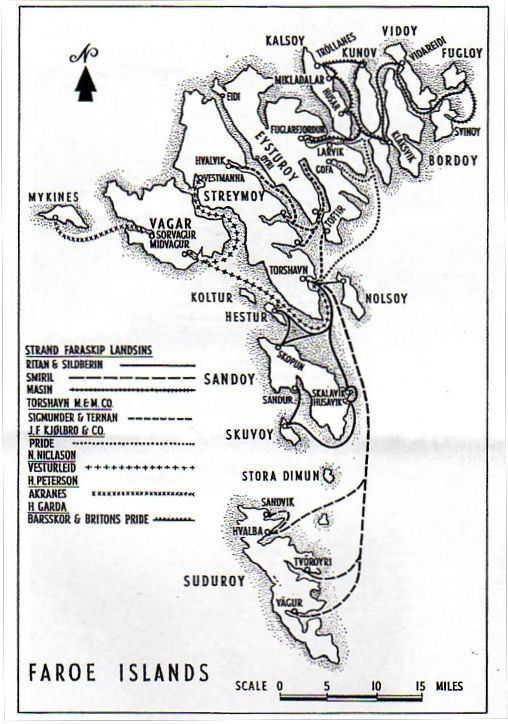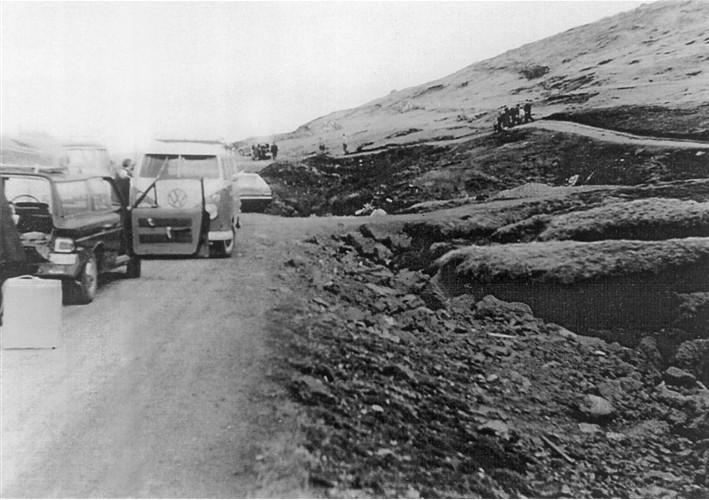 |
| The road to the airport (1) -
the start of the walk between the two roads at Hˇrisg°tu (Hˇreksg°ta)
in 1965 photo from the Bil of Tˇrshavn collection |
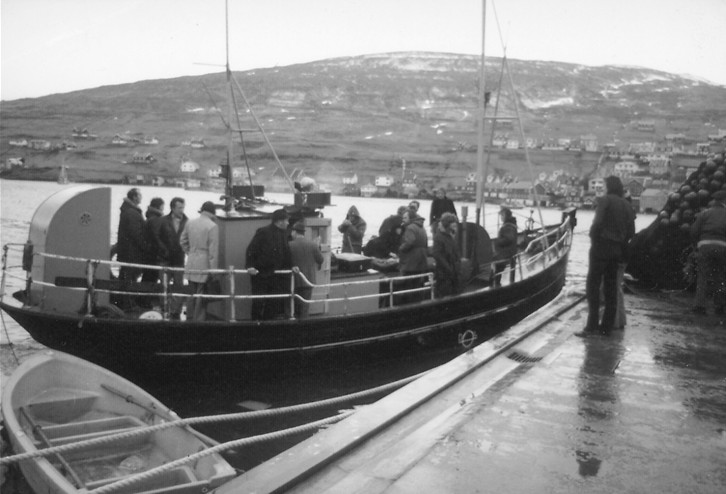 |
| The road to the
airport (2) -
ferryboat ĹOlavurĺ which linked Vestmanna to F˙taklett photo from the Bil of Tˇrshavn collection |
 |
| The road to the airport (3) -
the landing place at F˙taklett on Vßgar, with connecting bus to airport photo from the Bil of Tˇrshavn collection |
 |
| The road to the airport (4) -
the missing gap in the main road completed on 6th July 1966. As the road construction advanced and the gap was reduced a connecting taxi or bus service was offered from at least 1964. photo Mikkjal Helmsdal |
|
Bil trace their
origins as taxi operators in Tˇrshavn back to
the 1950s, and the firm grew
from taxis and ambulances and school transport, then eventually to
buses on the new road links. Subsequently they became a main
bus contractor for the state-sponsored Bygdaleiir bus network on the
routes from Tˇrshavn for some
twelve years or more, starting in 1980, including the route they had
served themselves since the mid-1960s to
Vestmanna. The Bil company was also the first contractor for the
Bussleiin town buses in Tˇrshavn when they started running in 1979,
continuing until contract changes brought in other operators in
1983. Whilst
so far most of
the transport provision in earlier
years had been provided by (usually small) commercial operators, from
1980 onwards the government network of Bygdaleiir country buses
started to develop and progessively assume the responsibility for
running the various routes, although the actual operation was most
often
sub-contracted to private operators. The 1981 timetable shows the
Bygdaleiir routes on Streymoy as Tˇrshavn - Kvivik - Vestmanna,
Tˇrshavn - Kirkjub°ur and Kvivik - SkŠling. The Kirkjub°ur route is
believed to have been the first to start. On the island of Sandoy the
Bygdaleiir routes were from Skopun to Sand and Skßlavik; Skopun to
Dalur and H˙savik; and to Skarvanes. The buses from Tˇrshavn to
K°llafjorur, HvalvÝk, Saksun, HaldarsvÝk, Tj°rnuvÝk, Eii and Gjˇgv
remained privately operated for a few years more, as did those on
Eysturoy and the southern island of Suuroy (the 1959 timetable shows
buses operating there regularly between the main towns of Tv°royri and
Vßgur, as well as to Fßmjin and Sumba; earlier there had been coastal
boats, some of which were still operating until the early 1960s). Similarly
by 1977 virtually all of the boat and ferry services were under
governmnent control through Strandfaraskip Landsins. The timetable for
1981 showed that Teistin sailed
from Tˇrshavn to Suuroy seven days a week, and also provided a direct
sailing to Klaksvik on Monday and Wednesday. Trondur went from Tˇrshavn
to Strendur and Toftir on Eysturoy, whilst Ternan sailed from Leirvik
to Klaksvik to round off the overland route. Barskor linked Kunoy and
Kalsoy to Klaksvik whilst Mßsin sailed from Hvannasund to the
northernmost isles of Svinoy and Fugloy. Ritan went from Tˇrshavn
to Nˇlsoy, Sandoy, Hestur and Koltur; and Sildberin onwards to Sk˙voy
from Sand. Sam linked Vestmanna to Oyrargjˇgv on Vßgar. An
earlier timetable from 1968 shows Strandfaraskip Landsins operating on
a smaller scale running Smiril (built 1932) to Suuroy; the first
instance of government involvement in shipping had been the
taking over of the running of the first Smiril in 1917 on the Suuroy
service. Ritan and Sildberin sailed to
Nˇlsoy, Sandoy and Sk˙voy; with Mßsin serving the northern
islands. Private operators still ran the other links, notably to
Vßgar, Eysturoy and the Sundini (see the 1966 map above) but time was
running out for most of the multi-stop local shipping services, as with
the development of the road network only the short point-to-point ferry
crossings would be needed in the future. |
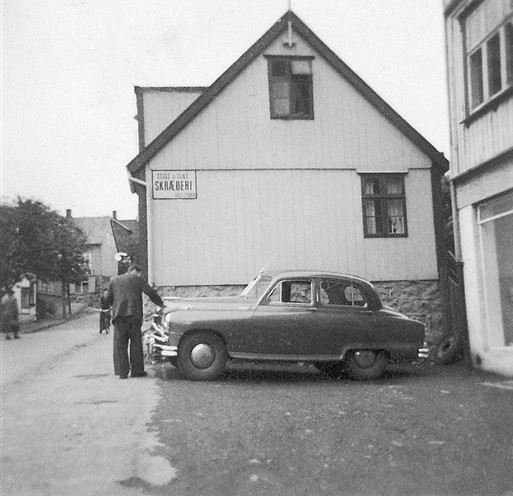 |
 |
|
| Bilst°in taxi departure point in
Tˇrshavn in Niels Finsensg°ta photo from the Bil of Tˇrshavn collection |
The 1960s Bil taxi fleet lined up in a
poster photo from the Bil of Tˇrshavn collection |
|
 |
||
| The ferry boat 'Litlaferja' photo from the Bil of Tˇrshavn collection |
||
|
|
 |
|
| Streymin
- the road bridge 'over the Atlantic' which opened in 1973 linking the islands of Streymoy and Eysturoy |
Cover of the wartime 1943 timetable
booklet - still published in Danish and not Faroese |
|
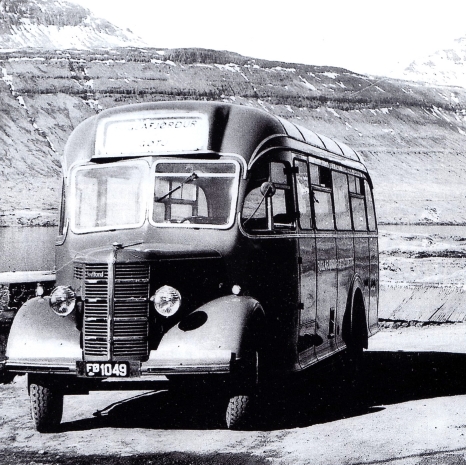 |
|||||
| Bedford
bus
of Sofus Joensen of Fuglafj°rur who ran from there across Eysturoy via
G°tu to S°ldarfj°rur for the boat to Tˇrshavn. This had been one of the first bus routes in the Faroe Islands. |
|||||
|
To travel
north from Tˇrshavn to the second city of Klaksvik there were
several options in the early 1970s, including a direct ferry once a day
between the two towns operated by either the 'Smyril' or the 'Pride'.
Alternatively one could take the ferry 'Trondur' from Tˇrshavn across
to Toftir, and then by car or bus across the island of Eysturoy to
Leirvik followed
by another ferry journey on the 'Ternan' to finally reach the
northern town of Klaksvik. This bus route had been pioneered as
early as about 1925 but ran northwards to Fuglafj°rur which was then
the main ferry port for
Klaksvik rather than Leirvik as in later years.
As 'capital' of the northern islands
Klaksvik on the island of Boroy served as a secondary transport hub
for boats and ferries to
the nearer islands of Kalsoy, Kunoy and Vioy, as well as to the other
more remote and distant islands of Fugloy and
SvÝnoy; the timetable for 1934 shows three vessels involved in that
work on different days, Immanuel, Guttaberg and Falken. |
|||||
 |
|||||
| The
ferry 'Sundaferjan' in the waters of Sundini photo from the Bil of Tˇrshavn collection |
|||||
|
Although the road
system on Streymoy was largely complete in the
mid-1960s there still remained at the time two distinct and separate
road systems
at either end of the island of Eysturoy. The opening of the 2.5
kilometre long tunnel in August 1976 between Oyrarbakki and Skßlabotnur
connected these two former halves and led to a significant
restructuring of public transport routes, including those linking
Streymoy with Eysturoy. For a few years though after the Streymin
bridge had opened in 1973 an hourly vehicular ferry, appropriately
named
'Sundaferjan', continued to operate across Sundini from Hˇsvik to
Selatra, but this ceased some time after the opening of the new road
tunnel. There were now through buses from Tˇrshavn across the new
bridge and through the new tunnel to the Eysturoy communities,
including RunavÝk and Toftir as well as Fuglafj°rur and Leirvik for
the Klaksvik ferry.
The direct ferry route between Klaksvik and Tˇrshavn all but ceased and
the Tˇrshavn ľ Toftir and Strendur ferry became a peak-hour only
operation and then
was finally withdrawn altogether in
2002. |
|||||
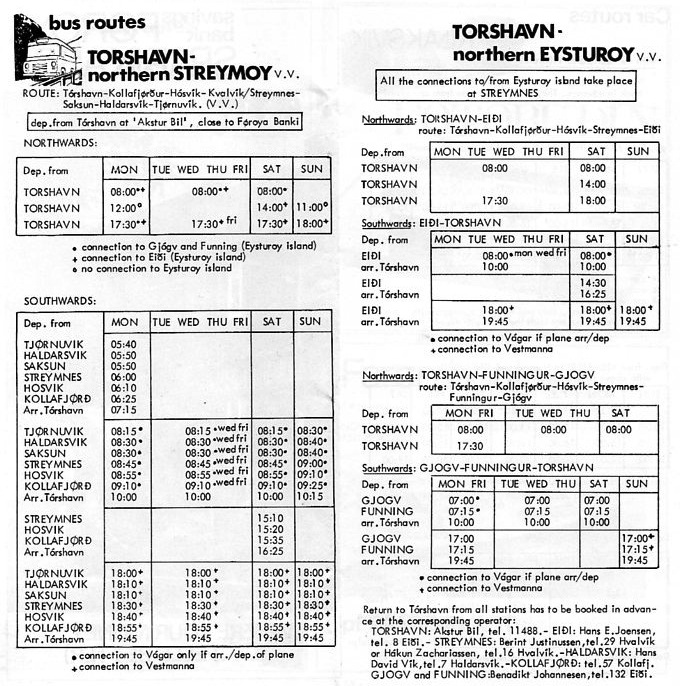 |
|||||
| Bus
timetable from the 1974 Faroes Travel
Guide, shortly after the opening of the Streymin bridge, with the
services on these routes provided by private operators working together. The state sponsored Bygdaleiir bus network commenced in May 1980. |
|||||
|
On
the island of
Streymoy, to reach the village of Kaldbak (now part of the enlarged
Tˇrshavn municipality) in 1974, you still travelled on the daily
ferryboat 'Sildberin'. Now the journey takes less than thirty minutes
on the four or five times a day bus. The shipping service ended in 1980
when the road to Kaldbak was completed. In the northern islands, to
reach
Kunoy from Klaksvik meant catching the ferry 'Barskor'. Thanks to a new
causeway and a three kilometre road tunnel opened in 1998, the journey
is
now easily accomplished by bus. Change came for the island of Sandoy
too in the mid-1990s, with the longish ferry journey from Tˇrshavn to
Skopun replaced by a much shorter crossing from a newly constructed
landing place at Gamlaraett (which is served by the buses on the route
to Kirkjub°ur). It was in the spring of 1993 that Gamlaraett was
brought into use. Trˇndur was the first ship to sail this route, and
today Teistin sails the route. |
|||||
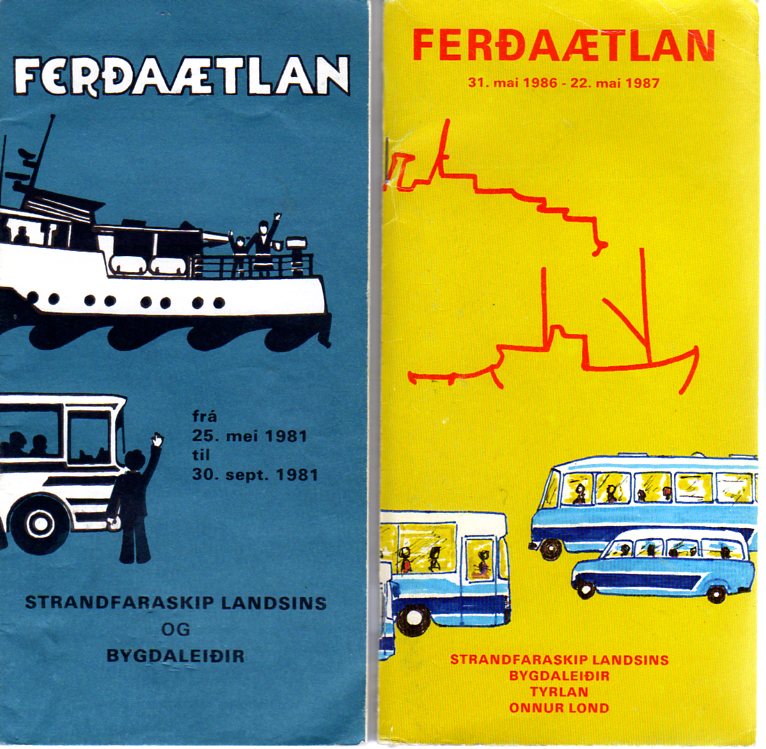 |
|||||
| Two
timetable covers from the 1980s for
the state sponsored bus and ferry network, with the 1986 timetable including inter-island helicopter flights (tyrlan) |
|||||
|
Now
the modern
day
Faroe Islands have a fully integrated state-owned and heavily subsidised transport system provided by Strandfaraskip
Landsins ferries and the blue country buses of Bygdaleiir (the latter was merged into Strandfaraskip in the 1990s). There are
through fares and through tickets, and the buses connect with each
other and with the ferries. As the tunnels and bridges expand, so do
the public transport opportunities. The 1993 road tunnel, 2.8
kilometres in length between Kaldbaksfj°rur and Kollfjarardalur, has
largely replaced the old upland Oyggjarvegur road (by way of Mj°rkadal)
between Tˇrshavn and Vestmanna and has considerably shortened the
journey time to and from the airport and northern destinations. Another
tunnel was built to link Streymoy to the island of Vßgar and now
through buses run to and from the airport. First proposed in 1989,
crossing from Leynar to near the old landing place at F˙taklett on
Vßgar, this
tunnel was opened in December 2002 and led to the demise of the ferry
service between Vestmanna and Oyrargjˇgv on Vßgar. Whilst this was good
for both the island and airport travellers it has put Vßgar, like
Eysturoy, within daily commuting distance of the capital. But in
counterbalance perhaps it will lessen the risk of depopulation from the
settlements in these islands. The Vßgar tunnel was the
first built under the sea in the Faroe Islands, so as the
Streymin bridge is known locally as the bridge over the Atlantic,
perhaps this will become known as the tunnel under the Atlantic? Just as there have been many changes in transport provision in the past, there may well be just as many changes still to come in future years. However in the Faroe Islands, as in other countries, public transport operation has to be set in practical and economic context against constantly increasing car use. With acknowledgement to the research and publications of Mikkjal Helmsdal 1916 - 1996. With many thanks to Bil of Tˇrshavn for
the use
of their
pictures This
article is still in development and
further information,
clarification or corrections are welcomed.
|
|||||
F°royar Upplřsing um bussar og ferja Ý F°royar - eg eri takksamur fyri hjßlp tina. |
|||||
|

